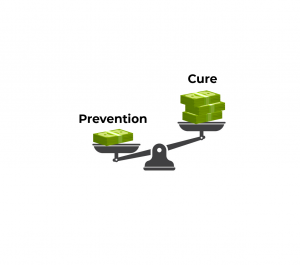Fraud Prevention vs. Loss Recovery – Why Humpty Dumpty Can’t Be Put Back Together Again

An ounce of prevention is worth a pound of cure, a stitch in time saves nine, and you can’t put Humpty Dumpty back together again. There are countless sayings about the importance of proactive, preventative measures, and they often underscore how repairing damage is more time consuming and challenging than preventing it.
These sayings aren’t just about illnesses, sewing, and eggs on walls. All of those sentiments also apply in the world of fraud prevention. Unfortunately, fraud is inevitable, and financial institutions have to spend money on it, but you have a choice: you can spend money upfront on fraud prevention or after the fact mitigating the damage. From a financial standpoint, it’s always better to focus on fraud prevention.
The Cost of Prevention
To prevent fraud, banks generally use a multi-pronged approach that includes everything from biometric tools to behavioral analytics to knowledge based authentication. Implementing and maintaining those safeguards costs money. On average, big banks spend over $20 million per year on fraud prevention, while community banks spend about $10,000 on fraud department salaries and another $10,000 to $50,000 on fraud prevention measures. These numbers may sound high, but in the long run, the costs are significantly lower than the cost of loss recovery.
The Cost of a Data Breach
According to the Cost of Data Breach Study by Ponemon Institute and sponsored by IBM, when businesses experience a data breach, the cost per compromised record is $141. That may not sound like much if you just imagine one customer’s records getting stolen, but most scam artists aren’t in the game for a single record. In fact, as of 2016, the average size data breach consists of 24,000 records. At $141 per record, that makes the cost of the average data breach approximately $3.4 million.
These numbers only deal with data breaches. Financial institutions also have to deal with the financial repercussions of scam artists who get into their client’s accounts, and those losses can also be staggering. Approximately, 86% of identity theft victims experience the fraudulent use of existing account information.
Damage to Reputation
On top of the measurable costs of loss recovery, such as finding the breach, stopping it, and dealing with public relations, financial institutions also need to consider the damage to their reputations. Keep in mind, customers want to trust their banks.
As evidenced by the infamous Target and Home Depot breaches, all kinds of businesses store a range of data on their customers, but the banks have the money. Because of that, consumers need to trust their banks even more than they trust their supermarkets, gyms, or department stores, and when banks fall prey to attacks, customers can lose faith in them.
If your bank becomes the victim of a data breach or if one of your customers’ accounts is affected by identity theft, that affects your reputation. New customers may be less likely to open an account or use your services, and your existing clients may look for another financial institution. That reduces the lifetime value of your clients and hurts your profitability in the long run.
Sadly, there have always been scams, and scam artists are constantly adjusting their strategies to find more effective ways to fill their pockets. To thwart their attacks, you need fraud protection you can trust. That’s where SQN Banking Systems comes in. We help you focus on fraud prevention so you can protect your financial institution and your customers. Contact us today to learn more.
